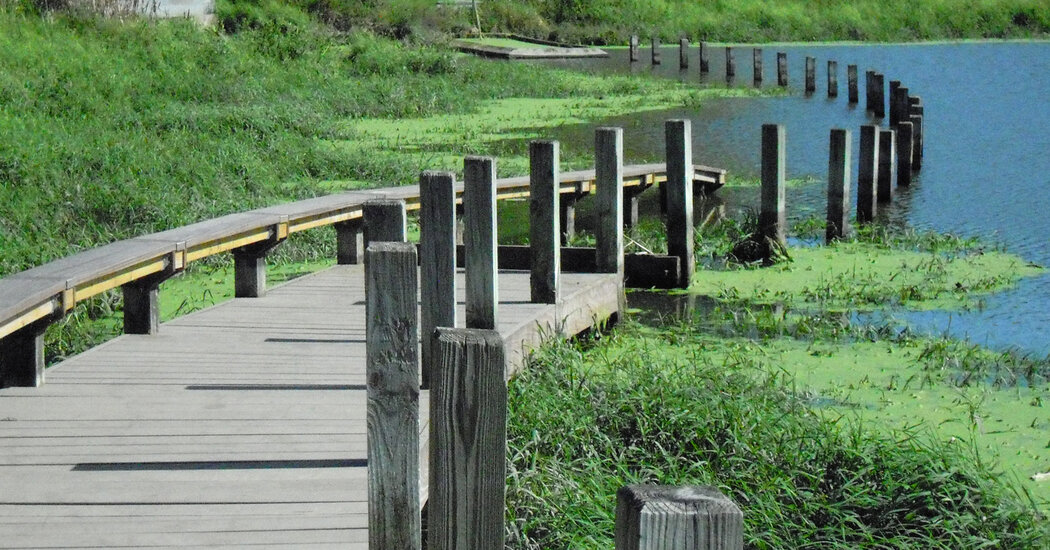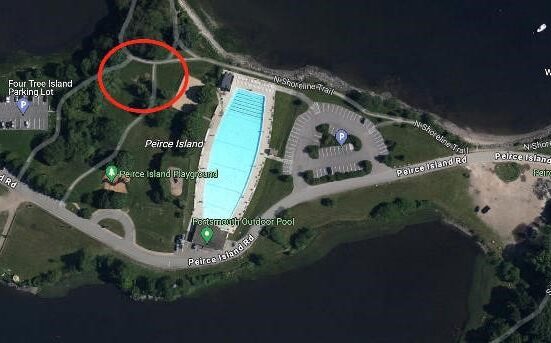The American land artist and designer Mary Miss was traveling in Europe in October when she received the kind of news that no one in her line of work wants to hear. One of her most significant artworks, owned by an Iowa museum, would need to be closed to the public because it had fallen into disrepair and parts of it were at risk of collapsing.
Six weeks later, Miss heard from the Des Moines Art Center that her environmental installation would be dismantled entirely. The word came from the art center’s new director, Kelly Baum, who said it would cost $2.7 million to repair the project, leaving the museum no choice.
Created between 1989 and 1996, “Greenwood Pond: Double Site” is one of the very few environmental installations in the collection of any American museum and is considered to be the first urban wetland project in the country. Its imminent demolition has angered landscape architecture advocates and upset Miss, who is part of a generation of pioneering female land artists receiving renewed scholarly attention.
“The things that have become so important in my later work — engagement of communities, collaboration with scientists, being able to take on something like climate change as an artist and have a seat at the table with politicians and educators — it started there,” Miss, 79, said by phone from her home in Manhattan. With its wooden boardwalk and concrete walkways that curve along the edge of the water and its cantilevered bridges, “Greenwood Pond: Double Site” invites passers-by to explore the landscape; viewers can climb up a tower to see the water from above or descend into a sunken structure to experience it at eye level.
The debate over the work’s fate has highlighted the difficulty of preserving public artworks, especially in environments with increasingly extreme weather. A wave of ambitious outdoor projects commissioned in the 1980s and ’90s have, over the past 15 years, required extensive maintenance or repair, according to Leigh Arnold, curator of the Nasher Sculpture Center in Dallas, who included Miss in the celebrated recent exhibition “Groundswell: Women of Land Art.” The case of “Greenwood Pond: Double Site” is “symptomatic of this greater problem around site-specific installations in that there is this kind of ‘set it and forget it’ attitude,” Arnold said.
In the late ’80s when artists were rethinking what sculpture could look like outside the white-cube gallery space, the Des Moines Art Center invited Miss, along with the sculptors Richard Serra and Bruce Nauman, to develop site-specific works for the city-owned park where the museum is situated. Miss chose a derelict pond. Over the course of seven years, she worked with Indigenous communities, a botanist from Iowa State University, and other groups to restore the area to its original wetland state. In its contract with Miss, in 1994, under the former director Michael Danoff, the museum pledged to “reasonably protect and maintain the project against the ravages of time, vandalism, and the elements.”
The museum says that “Greenwood Pond: Double Site” has been “consistently maintained” since its opening. In consultation with the artist, the museum completed extensive repairs in 2014 and 2015, according to Amy Day, its director of external affairs. But the use of residential deck wood, which has a life span of around a decade, was no match for Iowa’s extreme climate.
“We understand very well the desire to re-engineer and rebuild the work,” Day said. “However, Art Center does not have these resources.”
Miss noted that an outdoor project she made with the same materials in St. Louis has been incrementally upgraded over time, just as one might replace floorboards on a porch, and remains in good shape. She led the effort to repair another one of her installations, in South Cove, a public park in Battery Park City, in 2019.
Much of Miss’s work focuses on making city residents more aware of their surroundings and their connection to the natural world. For South Cove, Miss, along with the landscape architect Susan Child and the architect Stanton Eckstut, transformed a concrete platform above a landfill into a wild seacoast framed by subtle architectural interventions. Writing in The New York Times in 1990, Tony Hiss likened South Cove to New York fixtures like Central Park and Carnegie Hall for its ability to “stretch our understanding of our connections to one another and to the world the city serves.” In 2008, Miss founded City as Living Laboratory, a nonprofit that brings together artists, scientists and urban residents to tackle sustainability issues.
“It is ironic that other examples of Mary’s really ambitious public art projects aren’t in collections of art museums, yet they are cared for in a way that ensures they will continue to be a part of the public landscape,” Arnold, the Nasher curator, said.
The museum said that its agreement with the city of Des Moines to “remedy and/or remove any unsafe conditions related to artwork in Greenwood Park” takes precedence over its agreement with the artist. Ben Page, Des Moines’s director of parks and recreation, said that the city did not demand the work’s removal but supports the museum’s decision.
The treatment of Miss’s installation is symbolic of the art world’s tendency to undervalue environmental art, said Charles Birnbaum, the director of the Cultural Landscape Foundation, an education and advocacy group. The organization helped rally support for “Greenwood Pond: Double Site” in 2014 and is leading the opposition to its destruction. “Landscape architecture is treated as a second- or third-class citizen,” Birnbaum said. “Sometimes it comes from a lack of institutional memory — cultural amnesia for what they had.”
Miss said she was “shocked” by the museum’s estimate that it would cost $2.7 million to salvage “Greenwood Pond: Double Site.” She wondered if the work could be repaired in stages, rather than all at once, using a less expensive wood that could, in the future, be replaced at more regular intervals.
Birnbaum suggested that the museum consult the Des Moines Founders Garden Club or other patrons who might have an interest in funding the work’s preservation. (Baum, the director, told Miss she had had “numerous conversations” with the trustees, the city and individuals who helped fund the work’s rehabilitation in 2014.) In a letter sent to Miss on Jan. 17, the museum’s board wrote that any avenue that called for replacing the materials “is not financially feasible and does not comprise reasonable maintenance.” The museum’s operating budget in 2023 was $7.7 million.
For Miss, the decision feels especially ironic given her prominent position in recent exhibitions revisiting women whose contributions had been minimized by mainstream art history. Her work was included in “52 Artists: A Feminist Milestone,” a restaging of a 1971 exhibition organized by the critic Lucy Lippard at the Aldrich Contemporary Art Museum in Connecticut, as well as “Groundswell” at the Nasher. “Having this acknowledgment begin to surface a bit again and then again be erased — again? Really?” Miss said. “It’s just really hard.”







